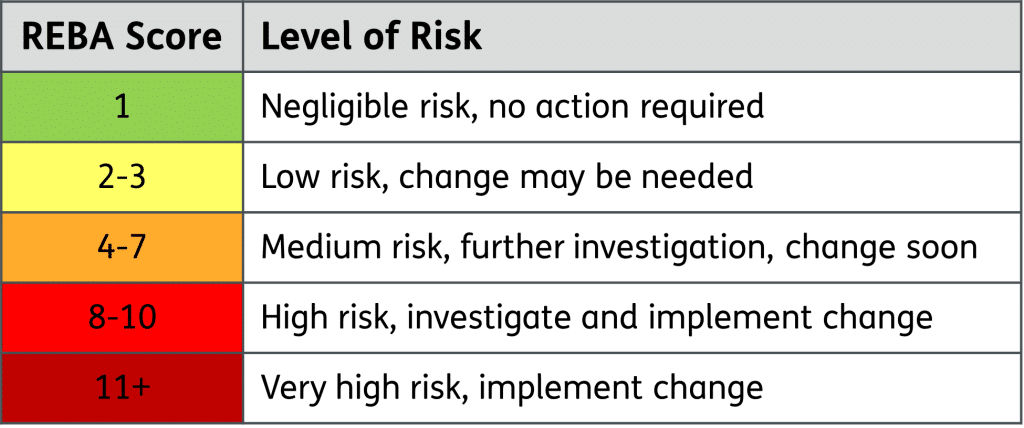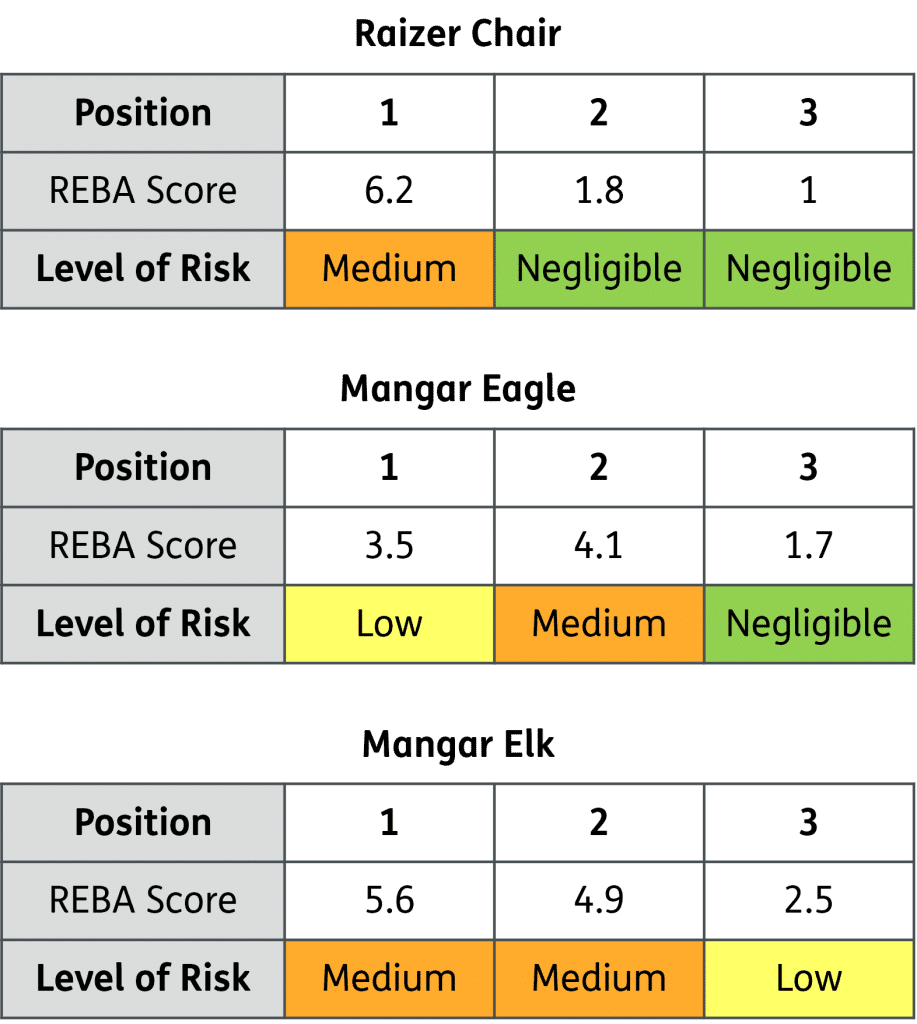An Ergonomic Comparison of the Raizer Chair vs Mangar Cushions from Anglia Ruskin University
Background to the study
Anglia Ruskin University is a public university in East Anglia, and one of the top universities in Cambridge. In 2022, Anglia Ruskin University carried out an ergonomic study of lifting devices, comparing the Raizer 2 Lifting Chair with the Mangar Elk and Mangar Eagle Lifting Cushions.
The aim of the study was to understand the effects of the use of lifting devices on both the operators and the people being lifted, and to do this they analysed three different stages of the lift:
Stage 1: Assisting the fallen person onto the equipment
Stage 2: Operating the lifting device
Stage 3: The movement of the patient on the lifting device
The following REBA (Rapid Entire Body Assessment) scores have been used throughout the study:

Stage 1: Assisting the fallen person onto the equipment
Method
To ensure that the assessment of the ergonomics during positioning of the person being lifted followed the manufacturer’s recommendations, Anglia Ruskin University utilised instructional videos for the Mangar Elk and the Eagle obtained from mangarhealth.com and an instructional video on how to use the Raizer Chair from Felgains.
Anglia Ruskin University carried out an ergonomic examination of these videos, providing a score for each of the following body regions: wrists, forearms, elbows, shoulders, neck, trunk, back, legs and knees.
Results
These scores were used to calculate an overall score at the most ergonomically demanding positions for each lifting device, as displayed below.
Anglia Ruskin University noted that there are two distinct ergonomically demanding positions for manually assisting the person being lifted onto the Mangar Elk, which is to first sit the patient upright and then assist the patient onto the cushion, so a REBA score was determined for each of these positions.

Stage 2: Operating the lifting device
Method
The aim of this section was to assess trained personnel using the lifting equipment to lift a fallen person. Eight volunteer participants were assessed, and each participant was either a paramedic or a student paramedic, having completed manual handling training.
A REBA scoring was provided for three distinct stages of the lift for all three devices:
- The starting position (referred to as ‘Position 1’),
- A midway lifting position (referred to as ‘Position 2’)
- And the final position (referred to as ‘Position 3’).
Results

Anglia Ruskin University comments;
“The lowest risks were associated with the Raizer Chair, having two negligible risks associated with positions two and three and a medium risk for position one.
“The risks associated with the Mangar Eagle were negligible, low and medium respectively for each position (1,2 and 3).
“The risks associated with position one were lower for the Mangar Eagle than the Raizer Chair. However, the increased risk was a consequence of the manual handler only needing to place a hand on the shoulders for support in position 1 for the Mangar Eagle, whereas, for the Raizer Chair, the manual handler was required to support the participant’s head. The REBA score risk can therefore be mitigated if the headrest for the Raizer Chair is utilised.
“The highest overall risk associated with manual handler positions was the Mangar Elk, with two medium and one low-risk position identified……..It was noted that there was consistent feedback from persons being lifted that they felt less stable on the Elk compared to the other two devices.”
Stage 3: The movement of the patient on the lifting device
Method
To compare the user experience of being lifted by the Raizer Chair and Mangar Elk, an analysis was completed within the Biomechanical Laboratory at Anglia Ruskin University. Eight participants without any form of musculoskeletal conditions were recruited to act as both manual handlers and people being lifted.
During the lifting process, data was collected from 8 motion capture cameras, and the participants were asked to provide verbal feedback on how stable they felt on the lifting device and how smooth the lifting movement felt.
Results
The graphs below show the vertical movement of participants’ shoulders when being lifted by each piece of equipment.
The central bold line represents the average movement and the shaded area represents the standard deviation of the movement. The increased variation visible in the Raizer Chair figure is a result of the differences in height of the participants.
Anglia Ruskin University states;
“The feedback from the participants being lifted mirrors that observed in the pattern of the vertical trajectory, with the perception that the Raizer Chair is faster, more stable and the movement was smoother. Feedback regarding the Mangar Elk is that the participant felt more vulnerable and required the support of a manual hander, the lifting process was less stable and prone to small movements in varying directions due to the inflating process.
“The participants felt more secure on the Eagle than they did on the Mangar Elk. However, as the Raizer Chair does not inflate, has a more solid feel, a smoother movement and the lift is completed substantially faster, all participants preferred the Raizer Chair to both the Mangar Eagle and the Elk.”

Key learnings and conclusion
The results from Stage 1 and Stage 2 indicate that the process of setting up and positioning someone for lifting on the Mangar Elk and Mangar Eagle presents a greater risk than that of the Raizer Chair. Similarly, the results from Stage 3 indicate that the Raizer was felt to be the smoothest and most stable from the point of view of the person being lifted.
The following important points from Anglia Ruskin University should also be noted:
- No analysis completed for the positioning or lifting process was classified as ‘very high risk’
- The REBA analysis does not account for the frequency at which the person analysed is in the position assessed. Therefore, if the lifting device is not used frequently, a ‘high-risk’ position is unlikely to cause musculoskeletal problems/conditions
- The analysis of the Raizer Chair did not utilise the headrest attachment. If the headrest was utilised, all REBA risk assessments for the Raizer would have been classed as ‘negligible’
- The frequency and environment which the lifting equipment is used within are likely to be quite unique to different users, therefore a trained Health and Safety professional should complete a risk assessment before use
- Due to the ergonomic demands of the lifting devices, users should complete manual handling training before using the devices
| Please click here to read the complete study from Anglia Ruskin University |
Related articles
Raizer Lifting Chairs vs Mangar Inflatable Lifting Cushions; An Honest Comparison
What Are The Consequences Of Falls In The Elderly?
4 Drawbacks of The Raizer Lifting Chair and Solutions
Get in touch
Got a question or want to send us a message? Let’s talk.

